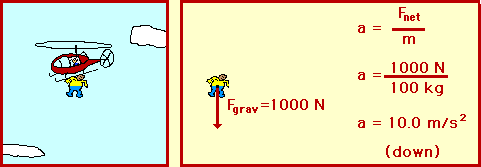
(4)

(4)
Galileo demonstrated that an object falling only under the influence of gravity will experience a constant acceleration, i.e.., it gains the same amount of velocity for every additional second that it falls. (5)
On earth this amounts to 32.14 ft/sec/sec, meaning that
it increases its downward velocity by 32.14 ft/sec for each second that
it falls.
If acceleration is constant, then it follows that the
downward velocity V an object experiences at any time t after the start
of the fall is given by:
V=g t
where V=velocity (m/sec)
t=time (sec)
g=acceleration due to gravity
One can also show that the distance d fallen after
time t is:
d= 1/2 gt^2
where d=distance fallen (ft)
g=12.54 ft/sec/sec for Mars
t=time (sec)
Furthermore, Galileo discovered that this acceleration
is independent of the body's mass, but dependent only on the strength of
gravity on the planet. So, in the absence of an atmosphere, heavy things
don't fall faster than light things, but at moderate to large velocities
even a thin atmosphere can have a significant effect on a falling body's
motion due to the effects of aerodynamic drag. (5)
Freefall...
When in freefall, a skydiver with arms and legs outstretched falls at about 120 mi/hr, with the arms in and the body in more of a diving position, the skydiver can reach speeds of up to 200 mi/hr. At this speed, many people believe that it is impossible to breath. Well, it is not impossible, but the truth is, you don't even need to breath because enough oxygen is absorbed through your skin to provide the blood cells with the required oxygen.
This is also why jumpers do not jump on cloudy days or
when they might risk going through clouds. The moisture in the clouds can
condense on their exposed skin surfaces preventing the absorption of the
necessary oxygen resulting in suffocation. (2)
Please view the FAQ's and myths page for more info.